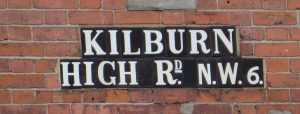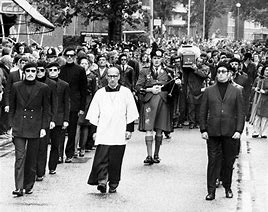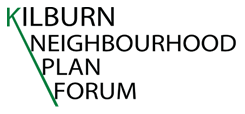Kilburn’s past
Kilburn has a rich history, and we can only give a flavour of it here.
Kilburn High Road originated as an ancient trackway, part of a Celtic route between the settlements now known as Canterbury and St Albans. Under Roman rule, the route was paved. In Anglo-Saxon times the road became known as Watling Street.
In 1134, Kilburn became a popular resting point for pilgrims heading for the shrines at St Albans and Willesden. This may have been the origin of the Red Lion pub, thought to have been founded in 1444. Opposite, the Bell Inn was opened around 1600, on the site of the old mansion. 
Some important Kilburn historical facts:
- Kilburn was a notorious duelling spot in C18-19
- Many industries grew up here – tile-making, bicycle manufacturing, railway signal factories
- Foyles bookshop started in Kilburn before moving to Charing Cross Road in the 1920s
- Kilburn has been split between two Boroughs for a long time – before Brent and Camden were established in 1965, we were split between the Boroughs of Hampstead and Willesden.
- The first cinema in Kilburn ‘The Biograph’ opened in 1910 at 236 Kilburn High Road.

- The State cinema on the High Road was the largest in Britain when it opened in 1937.
- Housing built for railway workers in the nineteenth century onwards attracted many people from Ireland and Kilburn became the centre of London’s Irish community.
- On the 8th June 1974, 3,000 mourners lined the streets of Kilburn and marched behind the coffin of Michael Gaughan, an Irish republican bank robber who died from hunger strike in Parkhurst. The coffin, flanked by an IRA ‘honour guard’, was carried to a Requiem Mass held in the Church of the Sacred Heart of Jesus, Quex Road.

- The Biddy Mulligan’s pub at the junction of the High Road and Willesden Lane, which was popular among the local Irish population, was bombed in retaliation on 21 December 1975 by the Ulster Defence Association (UDA), an Ulster loyalist group.
- HG Wells, George Orwell and AA Milne to name but a few, lived in Kilburn, but Sir Bradley Wiggins never did. He actually lived at addresses in Willesden Green and Maida Vale. But he did go to school in Kilburn – at St Augustine’s. He famously said: ‘Kids from Kilburn aren’t supposed to win the Tour’.
For more information go to:
http://brent.gov.uk/archives – Brent Council’s historical archive
http://www.willesden-local-history.co.uk/ – Willesden Local History Society
http://westhampsteadlife.com/2017/07/11/tracking-down-kilburns-misplaced-cinema/20063 A wonderful piece by Dick Weindling about Kilburn’s history in the entertainment business.
http://www.kilburntimes.co.uk/news/the-history-of-kilburn-a-rich-tapestry-1-956398 Ed Fordham’s 2011 article in the Kilburn Times.
https://en.wikipedia.org/wiki/Kilburn,_ London for the Wikipedia version.

